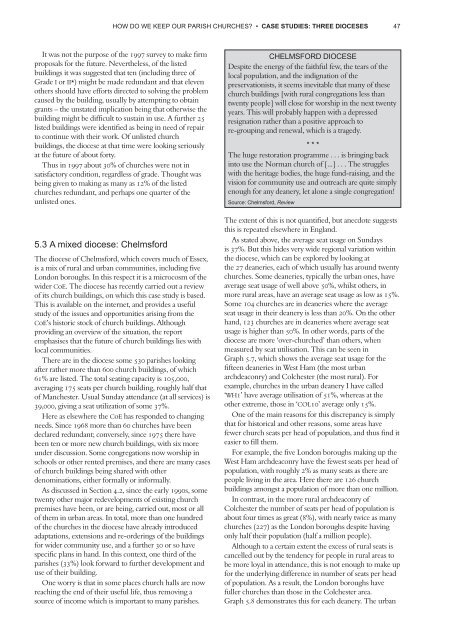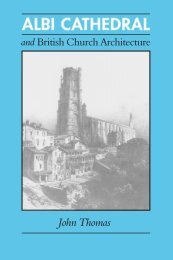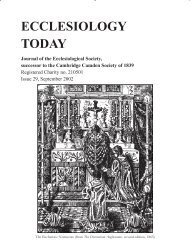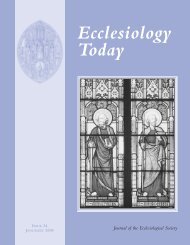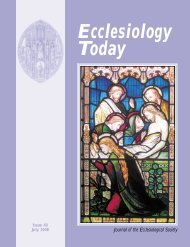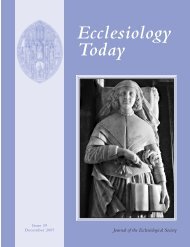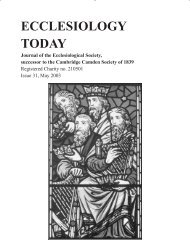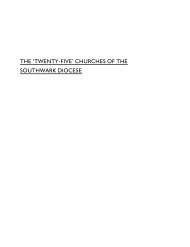PARISH CHURCHES? how do we keep our - Ecclesiological Society
PARISH CHURCHES? how do we keep our - Ecclesiological Society
PARISH CHURCHES? how do we keep our - Ecclesiological Society
Create successful ePaper yourself
Turn your PDF publications into a flip-book with our unique Google optimized e-Paper software.
HOW DO WE KEEP OUR <strong>PARISH</strong> <strong>CHURCHES</strong>? • CASE STUDIES: THREE DIOCESES 47<br />
It was not the purpose of the 1997 survey to make #rm<br />
proposals for the future. Nevertheless, of the listed<br />
buildings it was suggested that ten (including three of<br />
Grade I or II*) might be made redundant and that eleven<br />
others should have efforts directed to solving the problem<br />
caused by the building, usually by attempting to obtain<br />
grants – the unstated implication being that otherwise the<br />
building might be dif#cult to sustain in use. A further 25<br />
listed buildings <strong>we</strong>re identi#ed as being in need of repair<br />
to continue with their work. Of unlisted church<br />
buildings, the diocese at that time <strong>we</strong>re looking seriously<br />
at the future of about forty.<br />
Thus in 1997 about 30% of churches <strong>we</strong>re not in<br />
satisfactory condition, regardless of grade. Thought was<br />
being given to making as many as 12% of the listed<br />
churches redundant, and perhaps one quarter of the<br />
unlisted ones.<br />
5.3 A mixed diocese: Chelmsford<br />
The diocese of Chelmsford, which covers much of Essex,<br />
is a mix of rural and urban communities, including #ve<br />
Lon<strong>do</strong>n boroughs. In this respect it is a microcosm of the<br />
wider CoE. The diocese has recently carried out a review<br />
of its church buildings, on which this case study is based.<br />
This is available on the internet, and provides a useful<br />
study of the issues and opportunities arising from the<br />
CoE’s historic stock of church buildings. Although<br />
providing an overview of the situation, the report<br />
emphasises that the future of church buildings lies with<br />
local communities.<br />
There are in the diocese some 530 parishes looking<br />
after rather more than 600 church buildings, of which<br />
61% are listed. The total seating capacity is 105,000,<br />
averaging 175 seats per church building, roughly half that<br />
of Manchester. Usual Sunday attendance (at all services) is<br />
39,000, giving a seat utilization of some 37%.<br />
Here as elsewhere the CoE has responded to changing<br />
needs. Since 1968 more than 60 churches have been<br />
declared redundant; conversely, since 1975 there have<br />
been ten or more new church buildings, with six more<br />
under discussion. Some congregations now worship in<br />
schools or other rented premises, and there are many cases<br />
of church buildings being shared with other<br />
denominations, either formally or informally.<br />
As discussed in Section 4.2, since the early 1990s, some<br />
t<strong>we</strong>nty other major redevelopments of existing church<br />
premises have been, or are being, carried out, most or all<br />
of them in urban areas. In total, more than one hundred<br />
of the churches in the diocese have already introduced<br />
adaptations, extensions and re-orderings of the buildings<br />
for wider community use, and a further 30 or so have<br />
speci#c plans in hand. In this context, one third of the<br />
parishes (33%) look forward to further development and<br />
use of their building.<br />
One worry is that in some places church halls are now<br />
reaching the end of their useful life, thus removing a<br />
s<strong>our</strong>ce of income which is important to many parishes.<br />
CHELMSFORD DIOCESE<br />
Despite the energy of the faithful few, the tears of the<br />
local population, and the indignation of the<br />
preservationists, it seems inevitable that many of these<br />
church buildings [with rural congregations less than<br />
t<strong>we</strong>nty people] will close for worship in the next t<strong>we</strong>nty<br />
years. This will probably happen with a depressed<br />
resignation rather than a positive approach to<br />
re-grouping and renewal, which is a tragedy.<br />
***<br />
The huge restoration programme...isbringing back<br />
into use the Norman church of [...]...Thestruggles<br />
with the heritage bodies, the huge fund-raising, and the<br />
vision for community use and outreach are quite simply<br />
enough for any deanery, let alone a single congregation!<br />
S<strong>our</strong>ce: Chelmsford, Review<br />
The extent of this is not quanti#ed, but anec<strong>do</strong>te suggests<br />
this is repeated elsewhere in England.<br />
As stated above, the average seat usage on Sundays<br />
is 37%. But this hides very wide regional variation within<br />
the diocese, which can be explored by looking at<br />
the 27 deaneries, each of which usually has around t<strong>we</strong>nty<br />
churches. Some deaneries, typically the urban ones, have<br />
average seat usage of <strong>we</strong>ll above 50%, whilst others, in<br />
more rural areas, have an average seat usage as low as 15%.<br />
Some 104 churches are in deaneries where the average<br />
seat usage in their deanery is less than 20%. On the other<br />
hand, 123 churches are in deaneries where average seat<br />
usage is higher than 50%. In other words, parts of the<br />
diocese are more ‘over-churched’ than others, when<br />
measured by seat utilisation. This can be seen in<br />
Graph 5.7, which s<strong>how</strong>s the average seat usage for the<br />
#fteen deaneries in West Ham (the most urban<br />
archdeaconry) and Colchester (the most rural). For<br />
example, churches in the urban deanery I have called<br />
‘WH1’ have average utilisation of 51%, whereas at the<br />
other extreme, those in ‘COL10’ average only 15%.<br />
One of the main reasons for this discrepancy is simply<br />
that for historical and other reasons, some areas have<br />
fe<strong>we</strong>r church seats per head of population, and thus #nd it<br />
easier to #ll them.<br />
For example, the #ve Lon<strong>do</strong>n boroughs making up the<br />
West Ham archdeaconry have the fe<strong>we</strong>st seats per head of<br />
population, with roughly 2% as many seats as there are<br />
people living in the area. Here there are 126 church<br />
buildings amongst a population of more than one million.<br />
In contrast, in the more rural archdeaconry of<br />
Colchester the number of seats per head of population is<br />
about f<strong>our</strong> times as great (8%), with nearly twice as many<br />
churches (227) as the Lon<strong>do</strong>n boroughs despite having<br />
only half their population (half a million people).<br />
Although to a certain extent the excess of rural seats is<br />
cancelled out by the tendency for people in rural areas to<br />
be more loyal in attendance, this is not enough to make up<br />
for the underlying difference in number of seats per head<br />
of population. As a result, the Lon<strong>do</strong>n boroughs have<br />
fuller churches than those in the Colchester area.<br />
Graph 5.8 demonstrates this for each deanery. The urban


